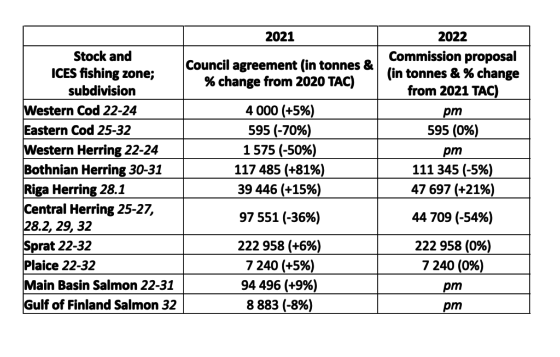Today the European Commission adopted their proposal for fishing opportunities for Baltic Fisheries 2022. The proposal mostly follows the ICES advice and proposes a TAC within the lower range for sprat and plaice considering the poor situation of the cod. For the Western herring it is suggested to close all direct fishery and a bycatch TAC will be proposed further on.
Eastern Baltic Cod
The eastern Baltic cod keep the 595 tonnes of bycatch TAC, which is the same as last year. The ICES recommendations of a zero-catch quota due to the severe state of the eastern cod is thus not followed, however the Commission acknowledges the poor status of the stock and highlights that the cod situation has not improved although measures taken already in 2019.
Western Baltic Cod lacking advice
The ICES advice for the western Baltic cod was postponed until mid-September, hence there is no proposal from the commission. Nevertheless, the poor status of the western cod is also recognized and the spawning closure is advised to remain, together with other measures in the eastern catch area due to the spatial mix of eastern and western cod.
Sprat and Central Baltic Herring
Sprat is given the same TAC as last year, although ICES gives room for an increase the commission argues the importance of sprat as food for cod, and the mixed fisheries of sprat and herring is considered to be a risk since the TAC for central Batic herring is proposed to be reduced considerably since the stock is not heallthy with the SSB below Blim. As an example the previous MSC certification of the central herring has recently been suspended.
Gulf of Riga
The only herring stock in good condition is the Gulf of Riga herring which is suggested an increased TAC. As FishSec has noted previously, it is the only stock which has consistently been fished in line with the Baltic multiannual management plan. Sustainable fishing and successful recruitment have contributed to a healthy biomass for the stock, which in turn has allowed quotas to remain at high levels.
Gulf of Bothnia Herring
The Gulf of Bothnia herring is proposed a slight decrease, however, due to a change in the ICES calculation model the stock status was changed from ICES category 5 to 1 and the stock biomass is currently considered to be larger than previously assumed. The estimation of a massive increase of biomass has, however, generated concern from scientists and other actors.
The western Baltic herring is in a bad shape and the commission proposes a close to all direct fisheries and only allow a TAC for bycatch (to be decided upon). Plaice is proposed the same TAC as last year, although ICES added space for an increase. The commission motivates the decision not to increase the TAC by the well-known high risk of cod bycatch in plaice fisheries.
Still no Salmon advice
ICES did not release any advice on the salmon, and the commission’s proposal will be updated when they are issued. Nevertheless, a special advice from ICES last year pointed at the MSY objective cannot be reached if the mixed sea fisheries continue at present level.
The adopted proposal is summarized below and can be found here.
